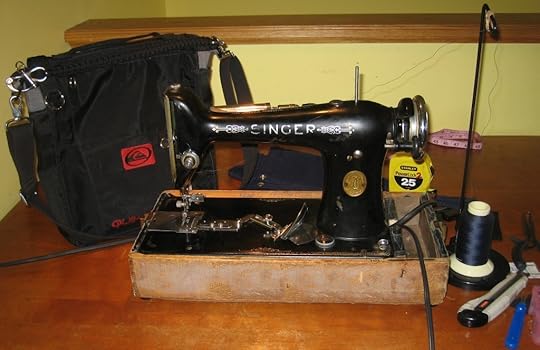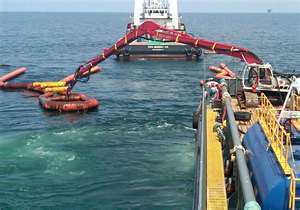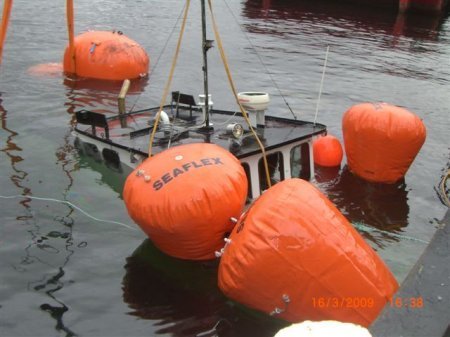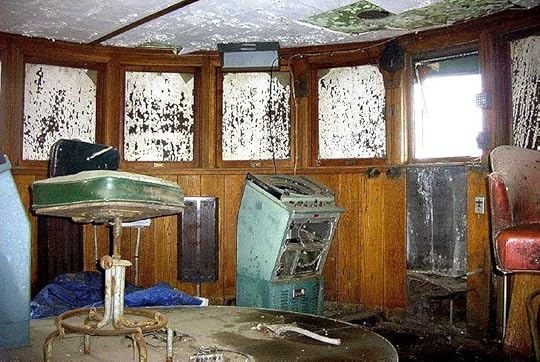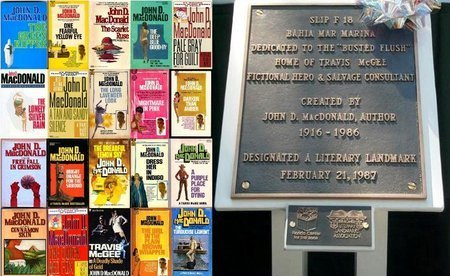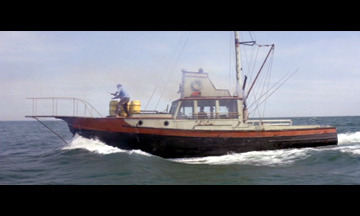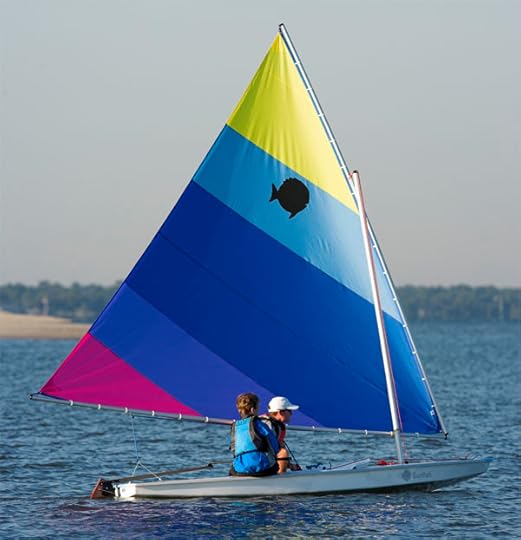Mike Jastrzebski's Blog, page 93
April 10, 2011
A Sewing we will go
By Mike Jastrzebski.
We're in need of new canvas for our Rough Draft so Mary and I bought a new sewing machine, a Sailrite Ultrafeed LSZ-1.
Before we left Minnesota in 2003 I made a new dodger, a sail cover and new cushions for the settees. I did it on an old Singer I had and I managed to get everything completed before we left Minnesota, but I swore that if I ever did it again I was going to buy a machine made to work on canvas.
I used to own a couple of sewing stores back in my pre-Mary days. Although I never really sewed, I was around sewers enough to pick up a basic knowledge and I went from there. This time, we decided that Mary would do the canvas-work. The problem is that Mary had not sewed a stitch since seventh grade, so I set out to teach her to sew. It was a little like the blind leading the blind. Yes, I'd done our original canvas work, but that was ten years ago and the new machine was a whole new learning experience for the both of us.
We started with a simple project, 2 roll-up plastic doors with sun covers for our cockpit entry. I figured what the hell, I'd done this before. I gave us two days to finish both doors–it took five.
Now I know everyone out there who has a boat is thinking-what was he thinking, everything on a boat takes three times as long to complete, but damn, I've done this before, and we still have a bimini and a dodger to make.
And now I have to ask myself, what about the evaporator I'm replacing on the fridge? I put the current one in five years ago; shouldn't it be a quick five or six hour job? Probably not.
And so I've been asking myself, is it just me? Have I forgotten just how long these projects took the first time I did them, or am I just slowing down with age?
Share on Facebook
April 7, 2011
Welcome guest Carol Newman Cronin
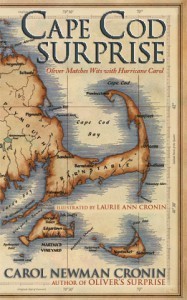 Please help me pipe aboard today's guest writer on the water, Carol Newman Cronin, Olympic sailor, YA author, contributing writer and editor for several boating publications. Her most recent novel is Cape Cod Surprise.
Please help me pipe aboard today's guest writer on the water, Carol Newman Cronin, Olympic sailor, YA author, contributing writer and editor for several boating publications. Her most recent novel is Cape Cod Surprise.
Stirring Stories from the Mental Melting Pot
by Carol Newman Cronin
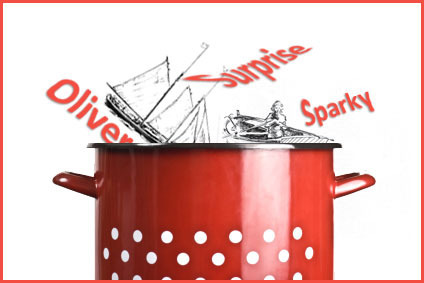 Last week I answered questions from a very bright third grade class. They asked about editing ("Do your stories change after you write them?"), and I told them that second drafts are where the real story appears. They asked about my sailing ("Did you just watch the Olympics, or did you actually play?"), so I tried to explain what an honor it was to represent my country.
Last week I answered questions from a very bright third grade class. They asked about editing ("Do your stories change after you write them?"), and I told them that second drafts are where the real story appears. They asked about my sailing ("Did you just watch the Olympics, or did you actually play?"), so I tried to explain what an honor it was to represent my country.
Finally, they got around to the big one: "Where do you get your ideas?"
After countless book signings and author interviews, I should be used to this question—but I have yet to develop a satisfying answer. I usually fall back on the stock reply: "my imagination." Since that's not really an explanation, here's an example.
I came up with the idea for Oliver's Surprise while gazing out the window on an October morning, trying to write a Christmas story for my 12 year old nephew. I stare out the window all the time, and usually I don't actually see what's right in front of me. But on this particular day, my eye was caught by a nondescript leaf blowing down the street toward Narragansett Bay.
At the end of our street is a small boat yard, which that year was struggling to redefine itself under a new owner. And moored off the boatyard was our 1938 Herreshoff Marlin, which would soon be hauled out for the winter.
As my eyes followed the leaf, I found myself wondering: what would happen if a 12 year old boy like my nephew decided to play hooky on a September afternoon, and he followed the leaf down the street to the boat yard…
And then my thoughts danced off in a practical direction: finding a yard qualified to haul an old wooden boat that survived the '38 Hurricane…
…until I dragged my mind back to the problem at hand: what would this boy find at the end of the street that was worth writing about?
And out of nowhere came the key phrase: "He travels back in time to 1938, just before the hurricane."
Without that last thought, I could've followed the fictional Oliver around for weeks without writing anything of interest. What made the story special was this step back into the past. I'd found a way to explore what a 21st century boy would find different—or not so different—about his grandparents' lives seventy years earlier.
Looking back on that fateful morning, it all seems so straightforward. Weeding out the real story, however, took a lot of writing and rewriting. Remember what I told the third graders about editing? In the first draft, I thought I was writing a story about a boy and his skiff, Sparky. It wasn't until the drawings arrived that I realized the story was about a boy and the schooner Surprise. A true surprise, even for the author.
Which is why it's so hard to describe where I get my ideas. The best ones are the mad stepchildren of experience gathered haphazardly together on a page—sparked into distinction by something as ordinary as an October leaf blowing down the street.
So the next time I get that question, "Where do you get your ideas?," maybe I'll say this:
"My ideas come from the melting pot of my life, stirred by the spoon of an idea, spiced with the details that blow past me every day, and left to simmer for weeks and months until the real story bubbles to the top."
Or maybe I'll just fall back on the safe answer: "My imagination."
 Carol Newman Cronin has sailed and written fiction since she was a child. In 2004, she crowned a lifetime of competitive achievement by winning two races for the USA at the Olympics. A member of the elite US Sailing Team from 2001–2007, she has won numerous national and international sailing championships. Since retiring from Olympic sailing, Carol has focused on writing and graphic design from her home office in Jamestown, RI. She and her husband spend as many hours as possible on the water. Follow her blog, Where Books Meet Boats.
Carol Newman Cronin has sailed and written fiction since she was a child. In 2004, she crowned a lifetime of competitive achievement by winning two races for the USA at the Olympics. A member of the elite US Sailing Team from 2001–2007, she has won numerous national and international sailing championships. Since retiring from Olympic sailing, Carol has focused on writing and graphic design from her home office in Jamestown, RI. She and her husband spend as many hours as possible on the water. Follow her blog, Where Books Meet Boats.
Share on Facebook
Making things work…
By C.E. Grundler
I recently had to change computers, which aside from the normal data-related headaches, created a secondary problem: transportation. My previous and slightly smaller computer slid easily into an old field bag with a multitude of handy compartments. That bag was vital as I traveled between the house, the boat and on the road, serving as a combination handbag/organizer/portable office, but now I needed to find a replacement. True laptop bags were a bit too bulky for day-to-day use, especially if I wasn't carrying the computer, while most messenger bags and backpacks lacked structure and those critical divided compartments. I needed a replacement but hadn't had the chance to find one and instead resorted to using one of my daughter's old school bags, a frayed model bearing the Hogwarts crest, where all the contents settled in a pile at the bottom.
A few days ago I had planned to work on the boat but it was one of those cold, rainy spring days, so I decided to tackle some canvas repairs that could be done at the comfort of the kitchen table. My daughter was off from work and cleaning her closet of old and outgrown clothes for Goodwill. As I took a break from sewing I looked over the collection of messenger bags from semesters past. Most had been retired due to broken zippers, frayed fabric and other wear and tear. All were repairable and each might have been workable, but none were ideal for my purposes. One had a great interior for carrying my computer, Kindle and notebook, with ideal pockets for my camera, recorder, pens and pencils, but the top closure was awkward. Another had a panel with pockets for my gum, Chapstick and a pill box of aspirin and No-Doz, but the fabric on the bottom was worn threadbare. And one bag was in decent condition and the ideal overall size, though its interior was a single undivided space. However, were I to take the best portion of each bag, combined with some canvas and some time at the sewing machine, it wouldn't be difficult to 'design' the perfect bag.
And thus Franken-Bag was born. From the remains of three messenger bags, two new zippers, and the webbing and fabric from a 2003 Mustang convertible roof, I now have the ultimate utility bag, complete with every feature I could possibly need. I chose the convertible fabric from last summer's roof replacement over the boat's navy blue Sunbrella: the black made for a better match and tougher exterior. I re-stitched the seams with UV resistant polyester thread and reinforced all wear-points to hold up to the roughest treatment. It wasn't all that difficult, didn't take very long, and with one heavy-duty sewing machine and years of experience sewing marine canvas, the end result looks quite professional.
What I find most surprising about a simple project like this is just how much it surprises some people. My non-sailing friends find this sort of behavior baffling and a bit strange; they can't understand how or why I do it. I find myself wondering if it's an old-boat thing, where fixing and modifying is a necessary skill and there's always that little tweak, that next refinement to make something work just a little bit better. Or does it come from writing, where sometimes an entire chapter clearly isn't working, yet within it may lurk a few really great passages. Ultimately the chapter or even the entire story may wind up in the closet of mothballed ideas, but certain passages, characters and concepts might resurface years later and be given a new life. Is it really that strange that I enjoy finding new ways to make old things work?
Share on Facebook
April 6, 2011
Water Muse-Guest blogger Rae Francoeur
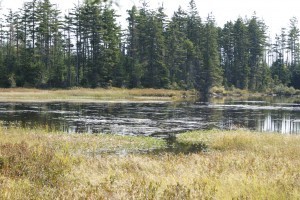
It's called Fourth Lake, though by Connecticut Lake standards, it's more puddle than lake.
Fourth Lake is a sludgy tannin-stained bog inhabited by frogs, dragonflies, Canada Jays and red-winged blackbirds. You have to climb vertically for about 45 minutes to get there, every once in a while catching pungent, sour whiffs of moose or a deer's abrupt snort of alarm. Some hikers' feet fit inside the hoof prints of the bull moose that have churned the trail into muck.
Once at Fourth Lake, you can walk its perimeter in an hour. You'll need boots that are water-treated because you are treading on a grand and fertile sponge.
Fourth Lake is sacred the way mothers and muses are sacred. This spittoon of a bog is the source of the Connecticut River and the Connecticut Lakes. Unlike the other lakes, you don't boat here and your dogs aren't allowed anywhere near it. Relatively speaking, it's pristine and rarely, if ever, will you encounter another human though you see their prints, too.
Fourth Lake sits on our border with Canada. The area just to the north has been ruthlessly clear-cut post 9/11 to give reconnaissance planes better border views. The trees, felled in a tantrum, are angled in all directions and take on the look of ten thousand booby traps.
To get to the trailhead, you have to drive to the terminus of Route 3 in New Hampshire, past the U.S. border guards, and, then, right before the Canadian border guards, you pull into a small lot. They no longer make you sign in and explain why you want to see Fourth Lake. The hike up to the lake includes several unsecured border crossings marked only by small brass plates embedded in the granite. What this means is that sometimes you've got one foot in Canada and one foot in the United States. As an aside, if you drove another few feet, you'd be on the Magnetic Hill in Canada. There, you can experience your car being dragged backward up a steep hill in some kind of astonishing and ever-amusing optical illusion.
I make an annual pilgrimage to Fourth Lake. When I go, I bring a lunch so I can prolong my visit. I sit on one of the felled tree trunks and stare across the bog. You never know what you are going to see on that busy surface forever a-roil in splashes. This is where life takes hold. Ripples radiate in circles everywhere across this buoyant breast.
One year, while crouched and savoring my ritual meal at the shore, I happened to glance at a small underground den capped by a pile of boulders — no doubt a glacial deposit. Inside that dark hole I thought I saw a flash of pink. Yes. I pulled out a small journal and a pen, wrapped in layers of plastic. It was covered in peat and had overwintered a couple of times.
Someone had begun a conversation about this place, and others had joined in. My daughter and I did the same, though by then the small pen skipped. No waxing effusively, then. The talk was about beginnings, about a tiny puddle that, at its southernmost spot, dribbled into something like a rivulet. One toddler's baby step could traverse the Connecticut River here! From Fourth Lake the 407-mile Connecticut River took hold and passed through New Hampshire and Vermont, Massachusetts and Connecticut before emptying into Long Island Sound in Old Saybrook.
What could be more reassuring to a writer than a dribble that works itself into something majestic? If nature says it, it must be so. Be persistent, then.
To get to Fourth Lake one year, my daughter and I needed to break the ice that had crusted on the granite with our fists in order to secure footholds. We had to get there.
The late Don Murray, my nonfiction writing teacher at the University of New Hampshire, gave us a piece of paper on the first day of class with the message: Nulla dies sine linea.
Never a day without a line. And no river of words without first one word, then another.
Rae Francoeur can be reached at rae.francoeur@verizon.net. Read her blog at http://www.freefallrae.blogspot.com/ or her book, "Free Fall: A Late-in-Life Love Affair," available online or in bookstores.
Share on Facebook
April 4, 2011
Honoring Nautical Tradition
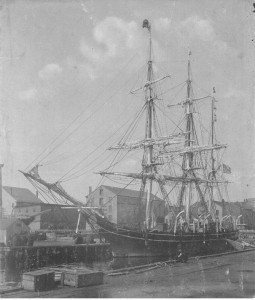
The Whaling Bark Sunbeam at the Pier in New Bedford, MA - Photo New Bedford Whaling Museum
I was writing a review of a Mainship trawler recently and while looking over the boat I noticed an actual Sampson post mounted behind the anchor windlass at the bow. A Sampson post is not unheard of but is somewhat less common on recreational boats these days. Most contemporary boaters will tie off their anchor rode to the post in order to relieve strain on the windlass capstan while at anchor. And it is also used when the boat is being towed. I'm sure most readers know these things about a Sampson post, even if they may not know that it served an even more central role aboard the tall sailing ships of earlier centuries. Except for workboats, today it is often just an artifact of nautical tradition. But seeing it on this contemporary trawler reminded me of a bit of historical research I did when planning the christening ceremony for my own boat back in 2003.
Our kids were still young teenagers then and we decided to take advantage of our Long Island location and buy a boat for the family to cruise the Northeast waters. It was a new build and rolled off the factory floor in March of 2004 and then was ferried from New Jersey to the dealer's marina on Staten Island. An earlier family history project had uncovered my great-grandfather's epic, nearly four-year voyage aboard a New Bedford whaling bark called the Sunbeam. So there was little question what we would name our new boat, even if we were happy that, with some small exceptions, the whaling business was no longer a condoned practice, or a current employer of any family member.
I wrote to the New Bedford Whaling Museum to ask one of the historians there what the christening ceremony of the original Sunbeam might have entailed. Fortunately for me, next to the Charles W. Morgan, which exists still as a floating whaling museum in Mystic, Connecticut, Sunbeam was one of the most well-documented whalers of the late 19th century. The Museum's historian sent me a detailed description of the ceremony along with some background on the practices of the day.
If you're wondering at this point what this has to do with Sampson posts, here's the (modest) payoff. Christening a whaler in the mid-1800′s involved smashing a bottle of rum on the Sampson post in a ceremony that involved mingling the symbolic prosperity and lifeblood of the sailors with the most stout piece of structure on the ship — the Sampson post. The newly christened Sunbeam then slid down the ways into Mattapoisett (MA) harbor. Some 20 years later, my 17-year old great-grandfather, George Nelson Tripp, left New Bedford on a voyage that took him to the Indian Ocean and back in search of whale oil.
Back to the future again and it is April of 2004 and my family is gathered at the bow of our own Sunbeam, at the dealer's dock on Staten Island. We decided to adapt the ceremony of the original Sunbeam for our own use.
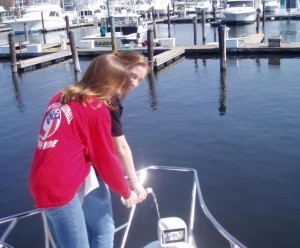
Allie and Emily Tripp Christen the 2004 Silverton Motoryacht Sunbeam
My daughters Allie and Emily read the following as the final part of the ceremony, while pouring the rum over our anchor windlass (which I promptly rinsed with fresh water in a fit of new boat-owner paranoia):
"As the great-great-granddaughters of the original Sunbeam crew, we hereby name this ship "Sunbeam," and ask her to safely carry her crew and guests to the sea and back. This rum symbolizes the life and prosperity of her original sailors and blesses her name. May she always find fair winds and following seas. Ladies and gentlemen, man this ship and take her to sea."
Share on Facebook
April 3, 2011
From Rags to Riches on the Kindle-March results
March was a bit of a milestone for me with my combined sales for both my books topping 5000 Kindle books sold since July of 2010. The breakdown is 2841 copies of The Storm Killer and 2383 copies of Key Lime Blues (A Wes Darling Mystery)
and 2383 copies of Key Lime Blues (A Wes Darling Mystery) sold.
sold.
There are two reasons why The Storm Killer has outsold Key Lime Blues to date. First, The Storm Killer went on sale 40 days before Key Lime Blues, and second, beginning March 16th I lowered the price of The Storm Killer from $2.99 to .99 cents. As of the 15th I had sold 189 copies of The Storm Killer and 333 copies of Key Lime Blues. I ended up selling 778 copies of The Storm Killer and 615 of Key Lime Blues by the end of the month. This was a good jump in sales for The Storm Killer but I needed to sell 6 times the number of books at .99 cents to break even and, as you can see, I only sold a little over 3 times as many copies of TheSstorm Killer. So it looks like I lost money on the deal.
Still, I decided to go with the .99 cent price throughout April. At the end of that time, unless there is a dramatic increase in sales, I intend to put The Storm Killer back up to the $2.99 price, or maybe I'll test out the $3.99 price point. Either way I'll post my results at the end of April.
Share on Facebook
March 31, 2011
Unpublished John D. MacDonald Manuscript Recovered
Fans of John D. MacDonald are ecstatic over news that an unpublished manuscript was found when a marine salvage operation raised the long lost wreck The Busted Flush in South Florida.
MacDonald, who died in 1986, grew up in upstate New York, but Florida became his adopted home. In all, he wrote more than 40 books including 21 in the Travis McGee mystery series. He also wrote The Executioners, which was twice made into a major motion picture under the title Cape Fear. His Travis McGee books were inspiration for many top writers ranging from Kurt Vonnegut to Stephen King to Carl Hiaasen.
MacDonald set the Travis McGee series in Fort Lauderdale where McGee lived aboard a houseboat named The Busted Flush that tied-up at Slip B-18 in the Bahia Mar Marina. The story holds that McGee took ownership of the boat and coined its name when he called the bluff of a man who held four of the five needed cards. What most people didn't know is that there really was a boat by that name and it appears that it involves its own mystery.
Here's an excerpt from Ocean Lines, which was the first to break the story:
A visiting tourist from New Jersey, Hazel Moran, heard an account about The Busted Flush from a local Floridian who knew MacDonald and spent time with him during the 1960's. Moran soon thereafter wrote an account in a local weekly that, as seen in the below excerpt brought the man's story to light.
"Life down here was more quiet back then. I did some diving and movie stunt work and when John learned about my diving he invited me to some parties he held. Nothing fancy, just some folks having a few drinks over by his dock at the end of the day. He asked me a lot about diving back then, maybe some of it ended up going into his books, I don't know. But he was a good guy to be around. A real nice fellow.
"What most folks don't know is that there really was a Busted Flush. It was an old Trumpy, one built up in Annapolis, Maryland. John lived over on the west coast but he'd come over here and stay on the Busted Flush. I never knew if it was John's boat or his friend's. It didn't really matter much, we were just having a good time. They called it a houseboat back then, but it was more like a small yacht. Nice brightwork and fine white hull. Didn't leave the dock much, though, it was more like a floating home over there in Bahia Mar.
"I thought it got sold when John moved from Sarasota to Siesta Key, but I later learned it was stolen. Some years after, I ended up finding out what happened and how it ended up being scuttled by the thieves. Wasn't much to do about it by then. I didn't really think anyone cared until I happened to mention this to someone a few months ago."
After reading Moran's account in a local paper, three amateur sleuths contacted her for more details. Aided by modern day sonar scanners, they found the hull sitting on the bottom about twenty miles north of Lauderdale. It was half-buried in sand stirred up by Hurricane David, a factor that made the recovery more difficult, but the sand was a saving grace because it preserved much of the wooden hull, allowing them to raise the yacht pretty much intact. And now they have not only the boat but also a lost manuscript that appears to be a yet unpublished Travis McGee novel, something that may be worth far more than the boat itself.
Again, quoting from Ocean Lines story:
Seychelle Sullivan, of Sullivan Towing and Salvage, organized the recovery. "It was all kind of a fluke," she said. "Wes Darling, who works as a private investigator from the Keys, heard about Hazel Moran's story one day when he was up in Fort Lauderdale. He knew about John D. so he saw the significance. Before he went any further, he found a college professor named Steve Decatur who helped him authenticate the find. When Wes and Decatur contacted me about going in on the salvage I immediately said yes. We laughed when we found out that each of us had read the Travis McGee books. Heck, we would have done this regardless of the money."
It turns out that the money part is, in fact, significant although it will have to be worked out in the courts. Maritime law and an insurance company will resolve ownership of the boat, but it's the manuscript that's generating the most interest. MacDonald's publisher is not commenting publicly on the manuscript's value, but it will likely earn a seven-figure contract.
"I'm just glad we found the boat and the book," Sullivan said. "They had a plaque over at Bahia Mar for a while, but this is a lot more than a plaque. Now we can really commemorate John MacDonald. We're talking about a never before published manuscript, plus The Busted Flush. I'd like to think Travis and John D. would be smiling right now, knowing what we've done. And the fact that the novel was stored in a waterproof box in the old Trumpy's wheelhouse won't be lost on fans. MacDonald was known to worry about hurricanes along the Florida coast, a subject that he took up in one of his later books, Condominium."
The book, which is expected to first appear in hardcover, will retain the original working title: An Azure April Fool.
Share on Facebook
The shark is not working…
If I had to choose a single movie as my all-time favorite, one that I will happily watch again and again, it would have to be Jaws. In fact, I consider Jaws essential mid-winter viewing, keeping me from climbing the walls while the river is frozen and Annabel Lee remains tucked in the shed awaiting spring. I realize most people hear 'Jaws' and think 'shark', which is understandable. But there is so much more. The character interactions are fascinating to watch, the dialog is brilliant, Jaws has some of the best 'on the water' scenes and even in her gritty, tired condition the Orca is (in my opinion) a thing of beauty. For me, there's much here to like.
And then there's Bruce. Some of you may have heard of the Bruce, the mechanical shark (technically 3 sharks) from 'Jaws,' nicknamed in honor or perhaps dishonor of Spielberg's lawyer. And yes, that's why the shark in 'Finding Nemo' is named Bruce as well. But what makes Jaws truly outstanding, what elevated it beyond a mere 'monster' movie is how rarely you actually see Bruce. From the first minutes of the film you know there's something out there. You're shown a thrashing girl, a severed limb, a chewed up boat… but no shark. You know the shark will appear but you don't know when. Then abruptly there it is, but only for a sudden glimpse as it slips beneath the surface, raising your anxiety even further.
The truth is this elevated suspense was never part of the original script. 'Bruce', the mechanical shark, was malfunctioning through much of the production. But schedules were tight and filming had to continue, so crews worked around the shark's absence by alluding to its presence. Docks were destroyed, yellow barrels skimmed along the water and were towed under and later pop to the surface, and of course, there was that famously ominous music. But watch Jaws and see how often the shark actually appears on screen. It's not much. Yet the end result was a far more terrifying movie that focused the plot around the small group of people as you watch them face to this unseen threat. Thanks to Bruce's lack of cooperation, what would have been a gory and likely somewhat cheesy horror went on to become a masterpiece of suspense. I truly believe if Jaws had been made today it wouldn't be half the movie it is; with modern CGI special effects it is too easy to show too much. The movie wouldn't have run up against the obstacles it encountered, things would have gone more smoothly, on schedule and on budget… and so much would have been lost.
There are several lessons that can be learned from Jaws. When I first began Last Exit In New Jersey, and again now with No Wake Zone, I set out with a plan. I outlined the story from beginning to end, then began tackling each individual passage. As I proceeded certain characters developed more than I'd originally expected, leading into new plotlines and taking the story in new directions. But I didn't let my original 'script' lock me in place and I didn't try to force my characters to follow their lines. If they came up with better dialog and action, I went with the flow. And I left the mechanical shark off the screen, instead hinting to what threat might lurk just out of sight, letting the reader sense its presence through other means. I made it clear there was something bad out there, but like my characters, readers didn't know its true nature, or when or where it might appear. I wanted readers to focus on the characters, to care about them, to know they were in danger, but not the extent of it or what will happen next. As with mechanical sharks, sometimes it's what we can't see that scares us the most, and the things that didn't go as planned that come together just right.
Share on Facebook
March 29, 2011
Sunfish & Short-shorts
C.E. Grundler's recent blog rang true to me. She had it right: when it comes to boats, to writing, and much more, "Taste is a Personal Thing." I'd add, too, that taste can differ on the occasion – a power boat one day and a Sunfish the next does it for me. In the same way, as a writer and a reader I can take joy from a novel and then find no less joy if I follow it with a short story. In fact, sometimes it's a very short story. Sometimes even an exceptionally short story.
How short? There's an often told tale that Ernest Hemingway once won a bet based on his ability to write a story in only six words:
For sale: baby shoes, never worn.
What's especially noteworthy here is that he managed to capture the elements of a story, including conflict and resolution.
Does six words seem too short for you? Then how about fifty-five? The California-based magazine New Times started an annual 55 word short story contest based on the following rules:
Fifty-five words or less (not including the title),
A setting,
One or more characters,
Conflict, and
A resolution.
I once tried my own hand at a 55, one set on the water. I drafted a few variations, which all went more or less along the following lines:
Come Back Please
"Mayday! Mayday! This is the captain of the fishing vessel Annabelle. Mayday."
"Annabelle, this is Coast Guard Station Chatham. Your location?"
"Fifteen miles off Monomoy. We're going down!"
"Annabelle, your coordinates?"
Silence.
"Annabelle, do you read me?"
Nothing.
"Annabelle, come back please."
More silence.
"Attention, mariners, this is the Coast Guard. Be on the lookout…."
Nothing about these short shorts is entirely new – Kafka, Chekhov, and others all took some turns at this. Yet, the advent of mobile e-readers and Smart Phones might just crack the market wide open.
So maybe it's time to practice up on this short form?
I was thinking along those lines not too long ago when I recalled a friend's account of how he moved from New York City to Providence after college. My friend had told me that when his father died his mother moved in with them in Rhode Island. Later, when she passed away, they followed her wish and she was buried in Providence. My friend told me, "She really liked Providence, so I had my father exhumed and re-buried next to my mother. And so now I own an empty grave site in New York."
I remember thinking that it was an interesting story unto itself, but it also started me wondering if I might be able to work on my own six-word riff on Hemingway's short. The result?
"Gravesite for sale, no longer used."
Nothing special, just a little bit of fun. Kind of like a Sunfish.
Share on Facebook
March 28, 2011
Writing while driving
Michael Haskins
I am on a book-signing road trip. I drove to North Carolina to spend a few days with my military intelligence source and then to NYC to see my daughters and their family and attend a few get togethers to sell Free Range Institution.
I drove because I no longer like flying and I am not in a hurry, so why not see some of the country. This is my third trip to NC and NYC.
I drive back to Key West for about ten days and then head to Houston for a signing at Murder by the Book, and then westward to SoCal for the LA Times Book Festival and three other signings. The signing information is posted on my website: www.michaelhaskins.net. If you are in any of the areas, please stop in and say hi.
When I left Key West, I had about 150+ pages written on my current project, Stairway to the Bottom. My friend and fellow writer Joe Moore asked me about it at a MWA luncheon last year and when I told him I was letting it write itself, he smiled – I think he wanted to pat me on the head as you would a lost child.
I used the drive time to NC and NYC to think about where the story was headed – writing in my head, I call it. I discovered some angles and twists that I hadn't thought about, created some dialogue, and finally pulled over at a rest stop and found my small recorder that was in the trunk with my laptop.
On the rest of the trip, I talked into the recorder and left myself notes of where the story was going, some twists to add to the story but still haven't come up with an ending I like. In my past three mystery novels – Car Wash Blues, being the third and due sometime in 2012 – I pretty much had the beginning, middle, and end sketched out before I started. The story never went the way I thought it would, taking turns and twists as the characters took over.
My idea for Stairway to the Bottom had a beginning and I thought it would write itself, as it seemed to have done with my other mysteries. It was going pretty well. I was 150+ pages into it when I left for my road trip.
The quiet time in the Miata let my mind wander and it didn't take long to get on the story line. I liked where I was in the story so far, so I thought ahead and saw some possibilities in the direction to go. One incident lead to another and soon dialogue was popping into my head and that's when I need the micro tape recorder.
When I get back to Key West, around the first full weekend in April, I will work from my taped notes and maybe get a chapter or two written before I leave for Houston and LA. But that's another long road trip and who knows what new twists to add to the story I might discover while driving.
If you are out driving somewhere between Florida and California, please drive carefully, the life you save might be mine.
Share on Facebook

